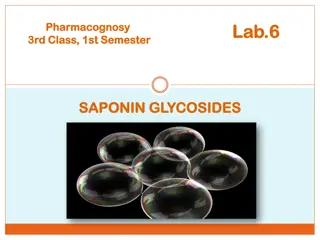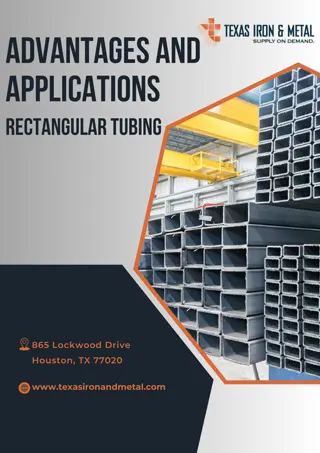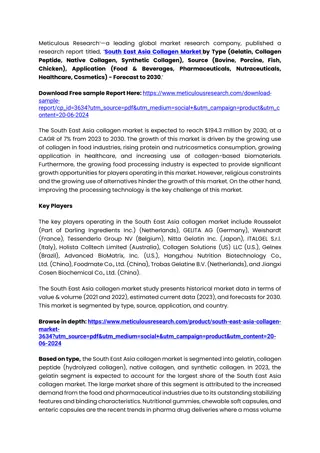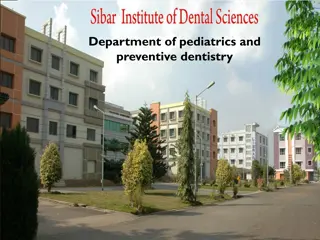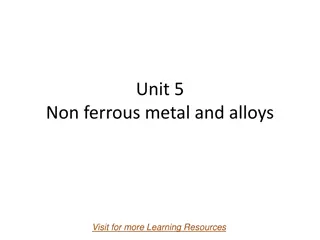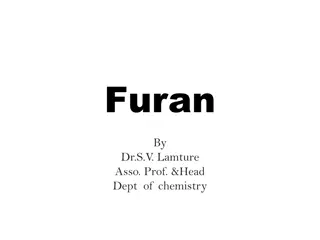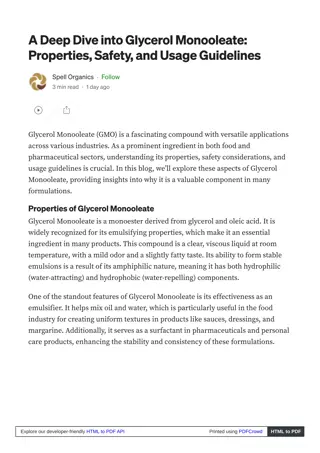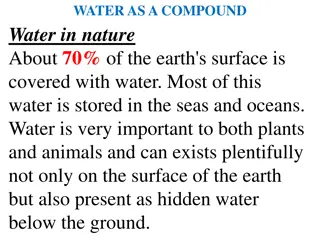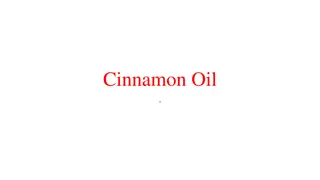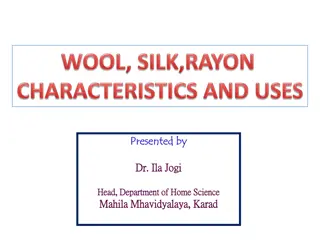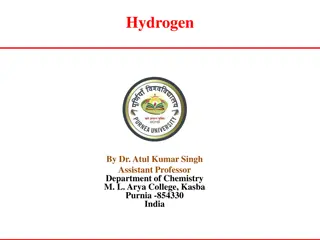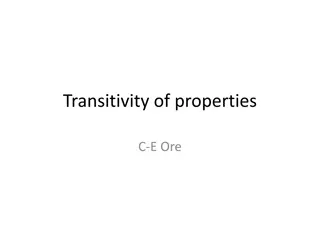Understanding the Versatile Applications of Chitosan and Its Unique Properties
Explore the multifaceted potential of chitosan, derived from chitin sources like crustaceans and fungi, in applications ranging from industrial membranes to medical scaffolds. Delve into its structural intricacies, including its semi-crystalline nature and allomorphic variations, which contribute to its unique properties such as water vapor permeability and tensile strength. Uncover how chitosan is utilized in various sectors, such as food, healthcare, and environmental remediation, showcasing its versatility and efficacy.
Download Presentation

Please find below an Image/Link to download the presentation.
The content on the website is provided AS IS for your information and personal use only. It may not be sold, licensed, or shared on other websites without obtaining consent from the author. Download presentation by click this link. If you encounter any issues during the download, it is possible that the publisher has removed the file from their server.
E N D
Presentation Transcript
Viscoelastic Properties of Crosslinked Chitosan Edible Films Joseph Khouri Supervisors: Profs. C. Moresoli and A. Penlidis Dept. of Chemical Engineering
Chitin Sources P R O D U C T I O N Main: Crustaceans (exoskeletal shells), Secondary: Fungi (stem walls), Squid pen, cuttlefish Chitin Chitosan conversion Protein removal De-colorization Mineral removal Deacetylation Base treatment, NaOH < 5 %, T < 80 oC Oxidation, KMnO4 or UV Acid treatment, HCl < 5 %, T ~ RT Base treatment, boiled NaOH > 40 %, T > 100 oC CaCO2 CaCO2 CaCO2 2
(1,4)-2-amino-2-deoxy--D-glucan S T R U C T U R E Units alternate by 180o m N-acetyl glucosamine residue n glucosamine residue DD = degree of deacetylation = 100 % n Chitosan = DD > 60 %, or > 7 % nitrogen Chitin = DD < 60 % or < 7 % nitrogen Okuyama et al. Macromolecules, 1997, 30, 5849-5855 Molecular weight commercial chitosan, Mv = 50 to 500 kDa 3
Semi-crystalline, 35 60 %; two-fold helical conformation (zig-zag); strong H- bond network S T R U C T U R E Allomorphs Tendon - hydrated - Orthorhombic - Anti parallel chain packing Annealed - Anhydrous - Orthorhombic - anti parallel packing annealed ~ 15o tendon ~ 10o Yui et al. Macromolecules1994, 27, 7601 - 7605 Okuyama et al. Macromolecules, 1997, 30, 5849-5855 4
A P P L I C A T I O N S Membranes/Industrial Technology Medical/Health Food - Thickener, stabilizer - Preservative - Appetite suppressant - Coatings/packaging - Heavy ion removal from waste water - Flocculating agent - Fuel cell membrane - Hydrogels for drug delivery - Scaffolds for bone regeneration - Hemostatic/ anticoagulant material - Cosmetics (skin, oral care) 5
P R O P E R T I E S Common plastics (LDPE, PP, etc..) Property Chitosan Water Vapor Permeability (WVP) [g/(m-s-Pa)] 1 10 10-11 0.01 1 10-11 Oxygen Gas Permeability (OP) [cm3/(m-s-Pa)] 1 10-15 1 10-13 1 10-13 1 10-12 Tensile Strength (TS) [MPa] Elongation Before Break [%] Young s Modulus [GPa] 1 100 1 - 100 1 50, 100 (with plasticizer) 1 1,000 0.1 3 1 - 10 Solvent casting, Limited molding Moldable (thermo-, injection, blow, etc ) Processability 6
M O D I F I C A T I O N Objectives for modification: (i) Reduce hydrophilicity, (ii) improve mechanical properties, while (iii) not causing significant changes to gas barrier or antibacterial properties Crosslinking Grafting Composites With hydrophobic compounds, lipids (e.g., stearic acid): Some improvement in hydrophobicity, some compromise in TS and antibacterial properties Improvement in antioxidation (with gallic acid) With hydrophobic compounds, lipids (e.g., palmitic, stearic, octanoic, acids): Some improvement in gas barrier Little to no improvement, in WVP, TS With polysaccharides: No significant change in properties With multifunctional compounds (e.g., tannic acid); - Some improvement in TS, WVP, and oxygen permeability - Some reduction of antibacterial properties 7
C R O S S L I N K E R S Epichlorohydrin Glutaraldehyde - Waste water treatment applications - Toxic - Biomedical applications - Total health impact / suitability for food applications still unknown Genipin Tannic Acid - Improvements in TS, WVP - Non-toxic - Improvements in TS, WVP - Non-toxic - Not fully studied with chitosan for edible film applications Citric Acid 8
C R O S S L I N K I N G Crosslinking with citric acid investigated with: Target application Food packaging Food packaging Superabsorbent hydrogel Starch Proteins (peanut, ) Carboxymethyl cellulose Hydroxyethylcellulose Hydroxy propyl methyl cellulose (HPMC) Chitosan-HPMC composite Chitosan-Alginate composite Chitosan graft on wool, cotton Chitosan, chitosan graft on polyurethane Food packaging Food packaging Drug delivery Textiles Food packaging, drug delivery, biomedical applications 9
C R O S S L I N K I N G NaH2PO2 105 190 oC, 5 min 6 hours, 5 30 % citric acid (w/w), 0 15 % catalyst 10
FTIR C R O S S L I N K I N G Reddy and Yang, Food Chemistry 2010, 118, 702-711 Rubber Elasticity Theory E elastic storage modulus G elastic shear modulus Mc average molecular weight between crosslinks R gas constant T temperature V Poisson Ratio crosslink density material density 11
V I S C O E L A S T I C I T Y Glass transition temperature, Tg, of chitosan in dispute. Estimates ~ 140 200 oC. Undetectable, weakly observable with DSC Chitosan/poly (N-vinyl pyrrolidone) E storage modulus E loss modulus tan( ) = E /E chitosan film Debate on the nature of the DMA tan( ) peak near 160 oC, glass transition vs. molecular motion of pseudo-stable state type Preheated chitosan film Sakurai Polymer2000, 21, 12 7051 - 7056
E X P E R I M E N T A L Films prepared from solvent casting with acetic acid (Ac) Neat Neutralized Glutaraldehyde (3, 6, 12 % w/w-chitosan), homogeneous and heterogeneous Citric Acid (15 % w/w-chitosan), with and without heat treatment (HT) (150 oC, 0.5 h) Homogeneous Crosslinking Neutralization Single step, Chitosan + Ac + crosslinker in solution Ac- Ac- NH3+ NH2 NH2 NH3+ neutralize NaOH Heterogeneous Crosslinking Multistep, prepare film, immerse in aqueous solution with crosslinker Ac- NH2 NH3+ NH3+ Ac- NH2 13
E X P E R I M E N T A L Dynamic Mechanical Analysis DMA Q800 (TA Instruments), tensile clamp Preheated Scans Equilibrated at 140 oC / 10 min Followed by regular scan Single Scan T-range = 30 200 oC q = 3 oC/min = 0.15 % f = 1 Hz (http://norleq.com/en/dt_portfolio/q800-dma-2-2/) 14
Effects of preheating R E S U L T S No Preheat Preheated 15
R E S U L T S Non-Preheated Films 16
R E S U L T S Preheated Films Peak 2 Peak 1 17
R E S U L T S Viscoelastic properties T (tan peak 2) [oC] 165 3 169 4 188 10 187 5 168 1 181 8 131 165 3 130 8 167 1 E' (195 oC) [MPa] 2382 127 2289 152 4143 334 4092 397 3264 146 3061 410 4479 635 4612 244 4727 349 4348 93 Film Preheated tan peak 2 0.216 0.045 0.213 0.034 0.078 0.001 0.078 0.003 0.100 0.013 0.129 0.045 0.096 0.051 0.004 0.097 0.026 0.061 0.005 N Y N Y N Y N Y N Y Neat Neutralized Glutaraldehyde CA+HT CA CV(E ) = 5 15 % CV(tan p2) = 4 25 % CV(Tp2) = 1 6 % CV = 100 % std. dev. / mean 18
R E S U L T S Peak Deconvolution Peak center - Gaussian distribution - Baseline chosen as lowest tan value Neat Glutaraldehyde no significant difference Heat treated and non heat treated citric acid films no significant difference Full Width at Half Maximum Neutralized Citric acid films no significant difference (FWHM-GLU > FWHM-CA) Heat treated and non heat treated CA films no significant difference 19
R E S U L T S Crosslinking with Glutaraldehyde 20
Concluding Remarks & Upcoming Work Contribution to knowledge on the viscoelastic properties of chitosan by incorporation of different crosslinkers and preheating conditions No strong evidence of covalent crosslinking - considerations for using catalyst (sodium hypophosphite) to promote this Investigate further heterogeneous and homogeneous crosslinking with glutaraldehyde; different concentrations, immersion times Test physicochemical properties (TS, WVP) of chitosan-citric acid crosslinked films 21
Clip art references lobster by Rutmer Zijlstra from the Noun Project Crab by Icons Producer from the Noun Project Shrimp by Iconic from the Noun Project Mushrooms by Bakunetsu Kaito from the Noun Project Squid by Cristiano Zoucas from the Noun Project doodle by Kyle Tezak from the Noun Project protein by Ricardo Moreira from the Noun Project Pill by Hopkins from the Noun Project Health by MRFA from the Noun Project membrane fabric by Olena Panasovska from the Noun Project Outfall by Luis Prado from the Noun Project packaged food by Made from the Noun Project protein powder by ProSymbols from the Noun Project Beaker by M rcio Duarte from the Noun Project drop by kareemovic2000 from the Noun Project tray by Smalllike from the Noun Project 23




